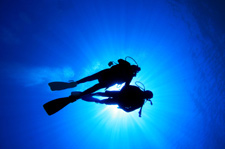
It’s a familiar sight – a stationary rib displaying a dive flag (either a red rectangle with a white diagonal stripe or a blue-and-white double-tailed pennant, the A or Alpha flag). Hopefully you will recognise these, know that there is a diver in the vicinity and keep your distance.
But what if one of the divers is in difficulty and needs help? Maybe the rib’s engine has failed and won’t start. They cannot get the diver to shore quickly for the necessary emergency aid he needs. How could you help? You might be the only boat in the area and his life could be in your hands.
Understanding breathing air at depth
The air we breathe consists of approx 79% nitrogen and 21% oxygen. Our bodies use the oxygen, but the nitrogen is inert (our body doesn’t use it). A diver’s compressed air in the scuba tank is essentially the same. The filling process filters the air to remove chemical impurities and most of the moisture, which can damage the scuba tanks. The nitrogen, however, though inert at the surface, changes as it is breathed in under pressure and at depths approaching 30 metres can have an intoxicating effect which intensifies as you go deeper.
Problems
Contaminated Air
Very occasionally there is a problem with the compressor or the filtering system, and the diver’s air becomes contaminated, maybe with carbon monoxide or oil vapour. This sometimes tastes and smells bad, but it can also be odourless and tasteless, and more difficult to recognise. A diver breathing contaminated air may be suffering from headaches, nausea, dizziness or even unconsciousness. Physical signs could be cherry-red lips and fingernail beds. Initial treatment is simply to get them to breathe plenty of fresh air, but oxygen should be given if it is available. Then make sure that they have medical attention as soon as possible.
Nitrogen Narcosis
Divers suffering from reaction to nitrogen behave as though intoxicated, with impaired judgement and coordination, and a disregard for safety. It affects people differently, and can combine with drugs or alcohol to affect people at lower depths. Fortunately the symptoms diminish when the diver nears the surface, with no after effects, so it is not in itself dangerous. The danger occurs because of the impaired judgement and coordination of the diver.
Decompression Sickness (DCS, also known as the bends or diver’ disease)
This is a dangerous condition arising from dissolved gases coming out of solution. The deeper the diver goes and the longer he stays down, the more excess nitrogen his body will absorb. When he ascends the nitrogen can’t stay dissolved so it begins to come out of solution, forming bubbles in the blood vessels and tissues. To counteract this, the diver must stop at regular intervals to allow decompression to occur. If he ascends too quickly he will be in danger of developing DCS. The signs and symptoms can vary depending on where these bubbles form, but can include paralysis, shock, weakness, dizziness, numbness, tingling, skin rashes and itching, difficulty breathing and pain in the joints and limbs. Severe cases can result in unconsciousness and even death. The symptoms can come on gradually and are sometimes intermittent, usually manifesting themselves anywhere from 15 minutes to 12 hours after a dive.
Anyone thought to be suffering from DCS should seek medical help immediately, as they may need specialist treatment in a decompression chamber where the diver is put back under pressure to help the body absorb the gas bubbles in the tissues. This will take time so first aid may need to be administered which includes drying and rewarming the diver, lying him down and giving oxygen if it is available. He should be monitored carefully to prevent or treat shock, and if he stops breathing or has no pulse, rescue breathing and CPR may have to be used. If vomiting occurs he should be moved to the recovery position (on his side). It might be beneficial to give fluids as this helps reduce dehydration, but no drugs should be given as they may mask the symptoms. He should be kept in a horizontal position until he arrives at an emergency care facility. The faster treatment begins, the less risk there will be of permanent residual symptoms. Even if no symptoms present themselves initially, if there is the slightest danger that a diver has stayed down for too long, or ascended too quickly, medical assistance should be sought.
To conclude – the chances are that you will never find yourself in a position where you have to give a diver first aid. In most cases his colleagues in the dive boat will be more than capable and knowledgeable. You never know, however, what can happen at sea and a little knowledge might just enable you to give someone assistance or even save their life.
Author – Dee White